10.1 Rotational Variables
Learning Objectives
By the end of this section, you will be able to:
- Describe the physical meaning of rotational variables as applied to fixed-axis rotation
- Explain how angular velocity is related to tangential speed
- Calculate the instantaneous angular velocity given the angular position function
- Find the angular velocity and angular acceleration in a rotating system
- Calculate the average angular acceleration when the angular velocity is changing
- Calculate the instantaneous angular acceleration given the angular velocity function
So far in this text, we have mainly studied translational motion, including the variables that describe it: displacement, velocity, and acceleration. Now we expand our description of motion to rotation—specifically, rotational motion about a fixed axis. We will find that rotational motion is described by a set of related variables similar to those we used in translational motion.
Angular Velocity
Uniform circular motion (discussed previously in Motion in Two and Three Dimensions) is motion in a circle at constant speed. Although this is the simplest case of rotational motion, it is very useful for many situations, and we use it here to introduce rotational variables.
In Figure 10.2, we show a particle moving in a circle. The coordinate system is fixed and serves as a frame of reference to define the particle’s position. Its position vector from the origin of the circle to the particle sweeps out the angle , which increases in the counterclockwise direction as the particle moves along its circular path. The angle is called the angular position of the particle. As the particle moves in its circular path, it also traces an arc length s. The particle may complete more than one revolution around the circle, and so the angle may be greater than , and the arc length s may be greater than the circumference, .
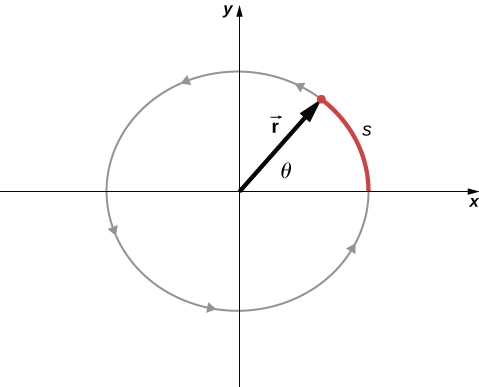
The angle is related to the radius of the circle and the arc length by
The angle , the angular position of the particle along its path, has units of radians (rad). There are radians in Note that the radian measure is a ratio of length measurements, and therefore is a dimensionless quantity. As the particle moves along its circular path, its angular position changes and it undergoes angular displacements
We can assign vectors to the quantities in Equation 10.1. The angle is a vector out of the page in Figure 10.2. The angular position vector and the arc length both lie in the plane of the page. These three vectors are related to each other by
That is, the arc length is the cross product of the angle vector and the position vector, as shown in Figure 10.3.
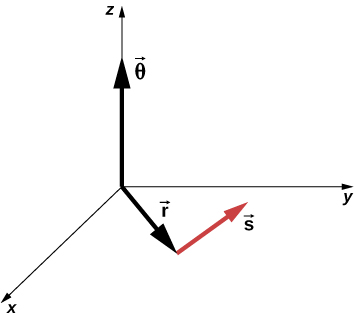
The magnitude of the angular velocity, denoted by , is the time rate of change of the angle as the particle moves in its circular path. The instantaneous angular velocity is defined as the limit in which in the average angular velocity :
where is the angle of rotation (Figure 10.2). The units of angular velocity are radians per second (rad/s). Angular velocity can also be referred to as the rotation rate in radians per second. In many situations, we are given the rotation rate in revolutions/s or cycles/s. To find the angular velocity, we must multiply revolutions/s by , since there are radians in one complete revolution. Since the direction of a positive angle in a circle is counterclockwise, we take counterclockwise rotations as being positive and clockwise rotations as negative.
We can see how angular velocity is related to the tangential speed of the particle by differentiating Equation 10.1 with respect to time. We rewrite Equation 10.1 as
Taking the derivative with respect to time and noting that the radius r is a constant, we have
where . Here is just the tangential speed of the particle in Figure 10.2. Thus, by using Equation 10.3, we arrive at
That is, the tangential speed of the particle is its angular velocity times the radius of the circle. From Equation 10.4, we see that the tangential speed of the particle increases with its distance from the axis of rotation for a constant angular velocity. This effect is shown in Figure 10.4. Two particles are placed at different radii on a rotating disk with a constant angular velocity. As the disk rotates, the tangential speed increases linearly with the radius from the axis of rotation. In Figure 10.4, we see that and . But the disk has a constant angular velocity, so . This means or . Thus, since , .
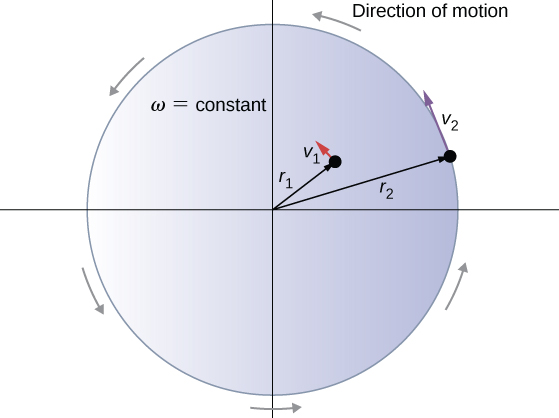
Up until now, we have discussed the magnitude of the angular velocity which is a scalar quantity—the change in angular position with respect to time. The vector is the vector associated with the angular velocity and points along the axis of rotation. This is useful because when a rigid body is rotating, we want to know both the axis of rotation and the direction that the body is rotating about the axis, clockwise or counterclockwise. The angular velocity gives us this information. The angular velocity has a direction determined by what is called the right-hand rule. The right-hand rule is such that if the fingers of your right hand wrap counterclockwise from the x-axis (the direction in which increases) toward the y-axis, your thumb points in the direction of the positive z-axis (Figure 10.5). An angular velocity that points along the positive z-axis therefore corresponds to a counterclockwise rotation, whereas an angular velocity that points along the negative z-axis corresponds to a clockwise rotation.
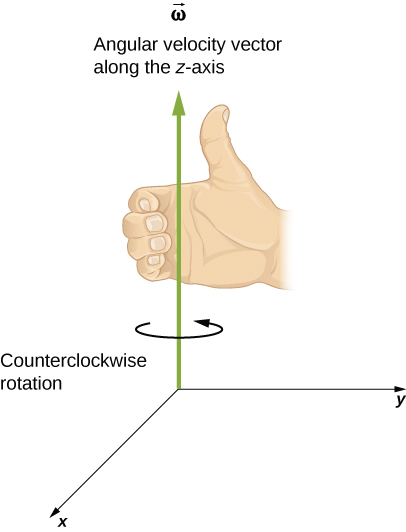
Similar to Equation 10.2, one can state a cross product relation to the vector of the tangential velocity as stated in Equation 10.4. Therefore, we have
That is, the tangential velocity is the cross product of the angular velocity and the position vector, as shown in Figure 10.6. From part (a) of this figure, we see that with the angular velocity in the positive z-direction, the rotation in the xy-plane is counterclockwise. In part (b), the angular velocity is in the negative z-direction, giving a clockwise rotation in the xy-plane.
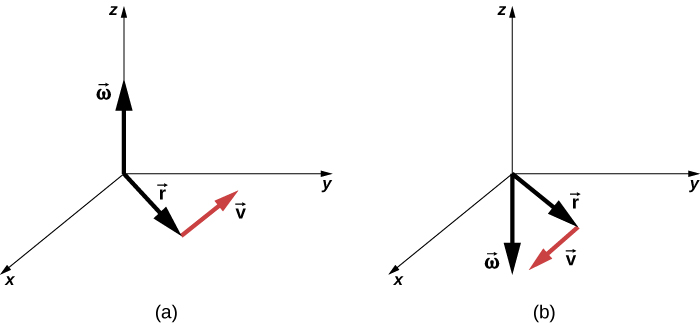
Example 10.1
Rotation of a Flywheel
A flywheel rotates such that it sweeps out an angle at the rate of radians. The wheel rotates counterclockwise when viewed in the plane of the page. (a) What is the angular velocity of the flywheel? (b) What direction is the angular velocity? (c) How many radians does the flywheel rotate through in 30 s? (d) What is the tangential speed of a point on the flywheel 10 cm from the axis of rotation?Strategy
The functional form of the angular position of the flywheel is given in the problem as , so by taking the derivative with respect to time, we can find the angular velocity. We use the right-hand rule to find the angular velocity. To find the angular displacement of the flywheel during 30 s, we seek the angular displacement , where the change in angular position is between 0 and 30 s. To find the tangential speed of a point at a distance from the axis of rotation, we multiply its distance times the angular velocity of the flywheel.Solution
- . We see that the angular velocity is a constant.
- By the right-hand rule, we curl the fingers in the direction of rotation, which is counterclockwise in the plane of the page, and the thumb points in the direction of the angular velocity, which is out of the page.
- .
- .
Significance
In 30 s, the flywheel has rotated through quite a number of revolutions, about 215 if we divide the angular displacement by . A massive flywheel can be used to store energy in this way, if the losses due to friction are minimal. Recent research has considered superconducting bearings on which the flywheel rests, with zero energy loss due to friction.Angular Acceleration
We have just discussed angular velocity for uniform circular motion, but not all motion is uniform. Envision an ice skater spinning with his arms outstretched—when he pulls his arms inward, his angular velocity increases. Or think about a computer’s hard disk slowing to a halt as the angular velocity decreases. We will explore these situations later, but we can already see a need to define an angular acceleration for describing situations where changes. The faster the change in , the greater the angular acceleration. We define the instantaneous angular acceleration as the derivative of angular velocity with respect to time:
where we have taken the limit of the average angular acceleration, as .
The units of angular acceleration are (rad/s)/s, or .
In the same way as we defined the vector associated with angular velocity , we can define , the vector associated with angular acceleration (Figure 10.7). If the angular velocity is along the positive z-axis, as in Figure 10.5, and is positive, then the angular acceleration is positive and points along the axis. Similarly, if the angular velocity is along the positive z-axis and is negative, then the angular acceleration is negative and points along the axis.
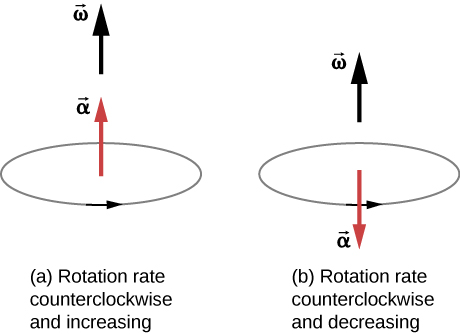
We can express the tangential acceleration vector as a cross product of the angular acceleration and the position vector. This expression can be found by taking the time derivative of and is left as an exercise:
The vector relationships for the angular acceleration and tangential acceleration are shown in Figure 10.8.
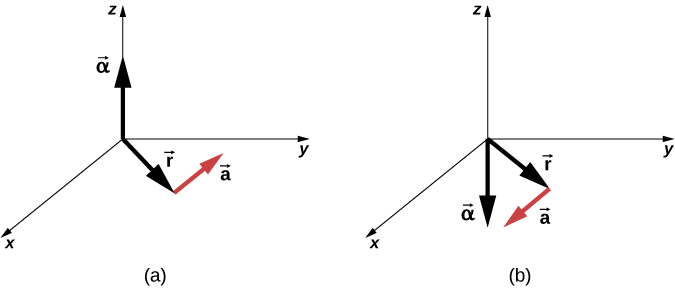
We can relate the tangential acceleration of a point on a rotating body at a distance from the axis of rotation in the same way that we related the tangential speed to the angular velocity. If we differentiate Equation 10.4 with respect to time, noting that the radius r is constant, we obtain
Thus, the tangential acceleration is the radius times the angular acceleration. Equation 10.4 and Equation 10.8 are important for the discussion of rolling motion (see Angular Momentum).
Let’s apply these ideas to the analysis of a few simple fixed-axis rotation scenarios. Before doing so, we present a problem-solving strategy that can be applied to rotational kinematics: the description of rotational motion.
Problem-Solving Strategy
Rotational Kinematics
- Examine the situation to determine that rotational kinematics (rotational motion) is involved.
- Identify exactly what needs to be determined in the problem (identify the unknowns). A sketch of the situation is useful.
- Make a complete list of what is given or can be inferred from the problem as stated (identify the knowns).
- Solve the appropriate equation or equations for the quantity to be determined (the unknown). It can be useful to think in terms of a translational analog, because by now you are familiar with the equations of translational motion.
- Substitute the known values along with their units into the appropriate equation and obtain numerical solutions complete with units. Be sure to use units of radians for angles.
- Check your answer to see if it is reasonable: Does your answer make sense?
Now let’s apply this problem-solving strategy to a few specific examples.
Example 10.2
A Spinning Bicycle Wheel
A bicycle mechanic mounts a bicycle on the repair stand and starts the rear wheel spinning from rest to a final angular velocity of 250 rpm in 5.00 s. (a) Calculate the average angular acceleration in . (b) If she now hits the brakes, causing an angular acceleration of −87.3 , how long does it take the wheel to stop?Strategy
The average angular acceleration can be found directly from its definition because the final angular velocity and time are given. We see that and is 5.00 s. For part (b), we know the angular acceleration and the initial angular velocity. We can find the stopping time by using the definition of average angular acceleration and solving for , yieldingSolution
- Entering known information into the definition of angular acceleration, we get Because is in revolutions per minute (rpm) and we want the standard units of for angular acceleration, we need to convert from rpm to rad/s: Entering this quantity into the expression for , we get
- Here the angular velocity decreases from 26.2 rad/s (250 rpm) to zero, so that is −26.2 rad/s, and is given to be –87.3 . Thus,
Significance
Note that the angular acceleration as the mechanic spins the wheel is small and positive; it takes 5 s to produce an appreciable angular velocity. When she hits the brake, the angular acceleration is large and negative. The angular velocity quickly goes to zero.Check Your Understanding 10.1
The fan blades on a turbofan jet engine (shown below) accelerate from rest up to a rotation rate of 40.0 rev/s in 20 s. The increase in angular velocity of the fan is constant in time. (The GE90-110B1 turbofan engine mounted on a Boeing 777, as shown, is currently the largest turbofan engine in the world, capable of thrusts of 330–510 kN.)
(a) What is the average angular acceleration?
(b) What is the instantaneous angular acceleration at any time during the first 20 s?
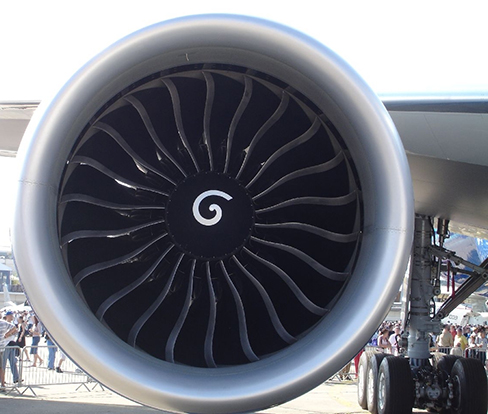
Example 10.3
Wind Turbine
A wind turbine (Figure 10.10) in a wind farm is being shut down for maintenance. It takes 30 s for the turbine to go from its operating angular velocity to a complete stop in which the angular velocity function is , where is the time in seconds. If the turbine is rotating counterclockwise looking into the page, (a) what are the directions of the angular velocity and acceleration vectors? (b) What is the average angular acceleration? (c) What is the instantaneous angular acceleration at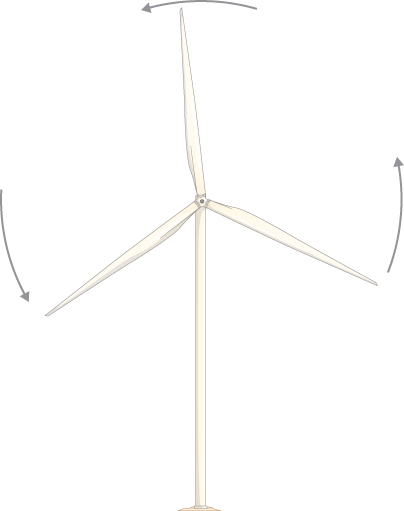
Strategy
- We are given the rotational sense of the turbine, which is counterclockwise in the plane of the page. Using the right hand rule (Figure 10.5), we can establish the directions of the angular velocity and acceleration vectors.
- We calculate the initial and final angular velocities to get the average angular acceleration. We establish the sign of the angular acceleration from the results in (a).
- We are given the functional form of the angular velocity, so we can find the functional form of the angular acceleration function by taking its derivative with respect to time.
Solution
- Since the turbine is rotating counterclockwise, angular velocity points out of the page. But since the angular velocity is decreasing, the angular acceleration points into the page, in the opposite sense to the angular velocity.
- The initial angular velocity of the turbine, setting . The final angular velocity is zero, so the average angular acceleration is
- Taking the derivative of the angular velocity with respect to time gives
Significance
We found from the calculations in (a) and (b) that the angular acceleration and the average angular acceleration are negative. The turbine has an angular acceleration in the opposite sense to its angular velocity.We now have a basic vocabulary for discussing fixed-axis rotational kinematics and relationships between rotational variables. We discuss more definitions and connections in the next section.